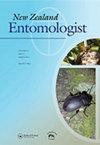一种生活在溪流中的水虻的夜间行为和触角感受器
IF 0.4
4区 农林科学
Q4 ENTOMOLOGY
引用次数: 1
摘要
摘要毛翅目许多物种的雌性在交配前都会使用信息素来吸引雄性。雄性和雌性的触角上都有一系列不同的化学感受器,它们可能介导两性之间的交流。Zelandophysic-ingens-Tillyard是一种大型的oeconesid-caddisfly,栖息在新西兰南岛的小森林溪流中。晚上,人们发现Z.ingens的雄性站在河床上伸出的大石头顶上,上下挥舞着它们的触角。这种行为被认为与检测到来自特定雌性的化学感觉信号有关。与此同时,雌性占据了河岸和河道内的各种底层。直接放置在溪流上方的双向粘性陷阱收集了大量低空飞行的雄性,特别是在它们的下游侧,这表明许多雄性可能是为了响应信息素线索而向上游移动的。一些被捕获的雌性在陷阱上产卵,表明它们正在进行产卵飞行。两性触角上的Sensila主要是前向的长槽毛状体,覆盖着许多两种形态的短星状假板状体,这两种形态以前从未描述过。本文章由计算机程序翻译,如有差异,请以英文原文为准。
Nocturnal behaviour and the antennal sensory receptors of Zelandopsyche ingens Tillyard (Trichoptera: Oeconesidae), a stream-inhabiting caddisfly
ABSTRACT Females of many species of Trichoptera (caddisflies) use pheromones to attract males prior to mating. A diverse array of chemosensory sensilla present on the antennae of both males and females are likely to mediate communication between the sexes. Zelandopsyche ingens Tillyard is a large oeconesid caddisfly, which inhabits small forest streams in the South Island of New Zealand. At night, males of Z. ingens were found standing on the tops of large stones projecting from the stream bed and waving their antennae up and down. This behaviour is thought to be associated with the detection of chemosensory signals from con-specific females. Meanwhile, females occupied various substrata on the stream bank and within the channel. Bi-directional sticky traps placed immediately above the stream collected large numbers of low-flying males, particularly on their downstream sides suggesting many may have been moving upstream in response to pheromonal cues. Some captured females had laid eggs on the traps indicating they were undertaking oviposition flights. Sensilla on the antennae of both sexes were predominantly forward-directed long grooved trichoids overlying numerous short stellate pseudoplacoids of two morphological forms that have not been described before.
求助全文
通过发布文献求助,成功后即可免费获取论文全文。
去求助
来源期刊

New Zealand Entomologist
ENTOMOLOGY-
CiteScore
0.70
自引率
33.30%
发文量
3
审稿时长
>12 weeks
期刊介绍:
The invertebrate diversity of New Zealand is of great interest worldwide because of its geographic isolation and geological history. The New Zealand Entomologist plays an important role in disseminating information on field-based, experimental, and theoretical research.
The New Zealand Entomologist publishes original research papers, review papers and short communications. We welcome submissions in all aspects of science regarding insects and arthropods in a New Zealand or Australasian setting. The journal’s subject matter encompasses taxonomy, phylogenetics, biogeography, biological control and pest management, conservation, ecology and natural history.
The journal is the official publication of the Entomological Society of New Zealand. Papers published or submitted elsewhere for publication will not be considered, but publication of an abstract or summary elsewhere (e.g. conference proceedings) does not preclude full publication in the New Zealand Entomologist. Accepted papers become copyright of the Entomological Society of New Zealand. The journal is published in English, but we also welcome publication of abstracts in Maori.
 求助内容:
求助内容: 应助结果提醒方式:
应助结果提醒方式:


